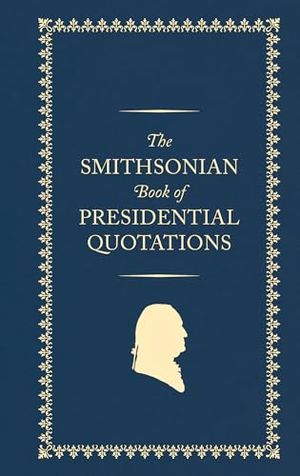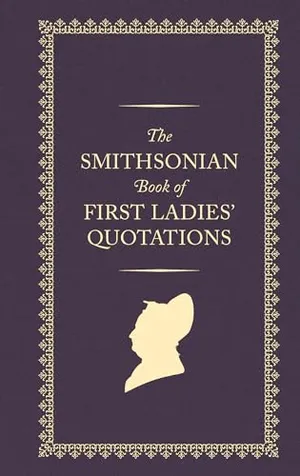How the Language of Presidents and First Ladies Shapes the Country
Smithsonian curators explore the power of words from the White House
:focal(800x602:801x603)/https://tf-cmsv2-smithsonianmag-media.s3.amazonaws.com/filer_public/d5/64/d564e068-69bc-4f6d-9d73-db85281d04b5/letter.jpg)
The Smithsonian Book of Presidential Quotations
Harry Truman once said that the “greatest part of the President’s job is to make decisions—big ones and small ones, dozens of them almost every day.” Even though these decisions can change the course of human events, the president’s job is largely done out of sight. We don’t watch the president work, and we only learn about the decisions when the president tells us about them. Even then, most people don’t hear the president’s words firsthand; instead, they encounter clips and soundbites chosen by someone else. In spite of this limited visibility, perhaps even because of it, the words presidents choose shape their administrations and our future. We would do well to listen.
Today the president can speak to the public instantaneously, if not incessantly, and because, as Lyndon Johnson once said, the presidency is the only office that belongs to everyone, the words of presidents can appear to matter more than those of others. That was not always the case. From George Washington’s Farewell Address to Andrew Jackson’s Bank Veto to Lincoln’s Gettysburg Address, some presidential statements captured the nation’s attention in earlier years, but not many. Throughout the nineteenth century, most presidential “speeches”—including annual messages and State of the Union addresses—were not speeches at all but written statements delivered to Congress on paper and made available to the public through the press. Even presidential candidates rarely campaigned in person; inaugural addresses were the only speeches expected to be given in person before a public audience. With just a few exceptions, the most eloquent speakers and the most important words came from Congress.
The Smithsonian Book of Presidential Quotations
A handsome collection of wise words from every US president, from George Washington to Joe Biden. This striking book shares inspirational, aspirational, and honest quotes from all 45 US presidents. Each page offers a glimpse into the lives and beliefs of leaders who have shaped the nation and its political landscape.
The balance of federal oratorical power started to shift from the legislative to the executive branch around the turn of the twentieth century. Rather than addressing Congress directly, especially when trying to advance an administration’s agenda, presidents began taking their policies directly to the people, engaging them as allies in persuading lawmakers. While many factors influenced the emergence of what has come to be called the rhetorical presidency, one factor stands out: the evolution of communication technology. The earliest presidential addresses appeared, usually in their entirety, in newspapers (some of which were highly partisan mouthpieces for the president’s party). Speeches were even printed on fabric, such as silk, to keep and display presidential words (including the longest inaugural address in history, William Henry Harrison’s at 8,445 words). The invention of sound and film recording made it possible for many more people to hear and see the president. In 1889, Benjamin Harrison was the first president recorded, but, in those days, the speeches were heavily excerpted. Film’s potential began to be realized with Theodore Roosevelt (who was filmed more than one hundred times) and Woodrow Wilson, both of whom embraced technology and travel, believing they could speak directly to the American people without having to go through Congress first. Radio’s growth in the 1930s enabled the words of Franklin Roosevelt, a gifted public speaker, to go directly into millions of homes. Now, in real time, the president could share all his words with the world, without Congress or editors intervening. Communication technology kept growing and presidents kept making it work for them. As FDR had excelled at radio, John F. Kennedy succeeded on television, Bill Clinton experimented with the internet, and Barack Obama and Donald Trump used social media to spread their words.
Through statements printed, recorded, televised, and tweeted, words from the nation’s communicatorin-chief have shaped administrations, our lives, and history itself. From Theodore Roosevelt’s excitement over his “bully pulpit” to Woodrow Wilson’s calling himself the spokesperson of the nation to Ronald Reagan’s commitment to communicate great things from “the heart of a great nation,” presidents have been profoundly aware of the importance and power of what they have to say. This volume gives you a taste of their words, from George Washington to Joe Biden, and from a variety of sources, representing the full range of rhetorical eras. No single speech is printed in full, but all presidents are represented in part. Explore these samples, read some full texts, listen to the speeches being given now and in the future. Decide for yourself which presidential words matter, and see where they might take us all. —E. Claire Jerry, Curator, Political History Smithsonian’s National Museum of American History
The Smithsonian Book of First Ladies’ Quotations
It can be difficult to find the voices of the first ladies of the United States. Unlike presidents, they do not begin their time in office by giving a public speech. For most of the years that the position has existed, it was considered unseemly for the first lady to express any opinions in public and certainly to comment on public matters. In her biography of her mother, Margaret Truman relates the story of Bess, while Harry was a US senator, telling his cousin Ethel Noland that, for political wives, “a woman’s place in public is to sit beside her husband, be silent, and be sure her hat is on straight.” Although their voices may have been lowered or sometimes muffled, first ladies have seldom been silent. Their words are found in letters and diaries written before, during, and after their time in the White House as well as in memoirs and reminiscences of friends and family. More recently we hear them in public speeches, interviews, and social media. As you will see in the Smithsonian Book of First Ladies’ Quotations, first ladies have voiced their thoughts on current events, given advice, vented frustrations, and celebrated, deliberated, consoled, and inspired friends, family, and the American people.
The Smithsonian Book of First Ladies' Quotations
An inspiring collection of wisdom from the women of the White House, from Martha Washington to Jill Biden
"The world of the future is in our making. Tomorrow is now." - Eleanor Roosevelt
The words of first ladies before the twentieth century are hardest to find. Although there were exceptions to the rule—authors, speakers, and activists— most women did not have access to public forums. Public opinion was that women should, as the old saying held, have their names appear in public only three times: when they were born, married, and died. Women who expressed their opinions in public ran the risk of criticism not just for their words but for being unladylike and bad role models for young girls. This was especially true for first ladies, who were expected to be the most refined and reticent examples of American womanhood.
Beginning with Martha Washington, first ladies have been uncomfortable under public scrutiny and high but often undefined public expectations. On her way to join the new president in New York, Lady Washington, as she was called, gave public thanks to the troops accompanying her on the journey and for the warm greetings that she received along the way.⁄ Her remarks were reported positively in newspapers, but the same papers and public later made Martha Washington sometimes feel, as she wrote in a letter to her niece Fanny Bassett Washington, “more like a state prisoner than anything else.” Perhaps it was that fear of scrutiny and judgment that spurred her to burn almost all her correspondence with her husband after his death, protecting the words of both from public scrutiny. More than 150 years later, Bess Truman, who guarded her privacy as first lady, also burned some of her letters to her husband. When Harry objected, asking her to “think of history,” the former first lady responded, “I am.”¤ In the twentieth century, first ladies began to speak publicly. They used speaking engagements and media to lend their support to causes near to their hearts and make connections with the American people. Helen Taft publicly supported woman suffrage and greater career opportunities for women.‹ Lou Hoover was the first to use radio to connect with listeners, broadcasting talks to boys and girls clubs to promote physical fitness and shared responsibilities between boys and girls.› Eleanor Roosevelt expanded the use of radio and used the airwaves along with press conferences, speeches, and her newspaper columns to reach out to the public throughout the Great Depression and World War II with messages of hope, advice, and calls to action.
Modern first ladies, like presidents, find that their every utterance is recorded and analyzed. Scrutiny made some of them less likely to speak in public, while others used their platform to its fullest. They have campaigned for their husbands and other candidates. They have discussed political and social issues, promoted their own initiatives, detailed their goals, and touted their achievements. Some have been willing to talk about their families and life in the White House. They have answered questions, offered advice, and sent messages of comfort.
The words of the first ladies give us a glimpse into their private lives as well as their public personas. Some observances meant for family and friends reveal more of their unguarded personalities, while their public comments, delivered to inspire and influence, reveal their hopes and aspirations. Together they bring us greater understanding of the first ladies and their impact on their fellow Americans. —Lisa Kathleen Graddy, Curator, Political History Smithsonian’s National Museum of American History
The Smithsonian Book of Presidential Quotations and The Smithsonian Book of First Ladies Quotations is available from Smithsonian Books. Visit Smithsonian Books’ website to learn more about its publications and a full list of titles.
Excerpts from The Smithsonian Book of Presidential Quotations and The Smithsonian Book of First Ladies Quotations © 2024 by Smithsonian Institution
A Note to our Readers
Smithsonian magazine participates in affiliate link advertising programs. If you purchase an item through these links, we receive a commission.


